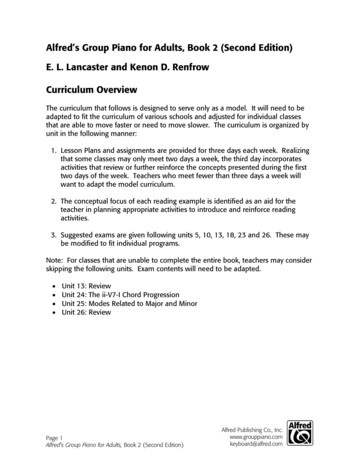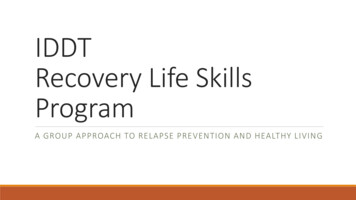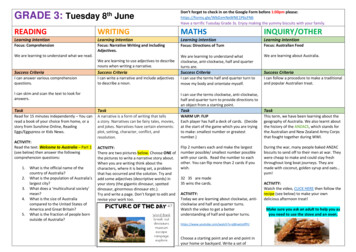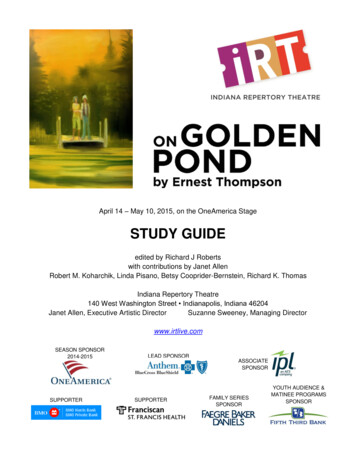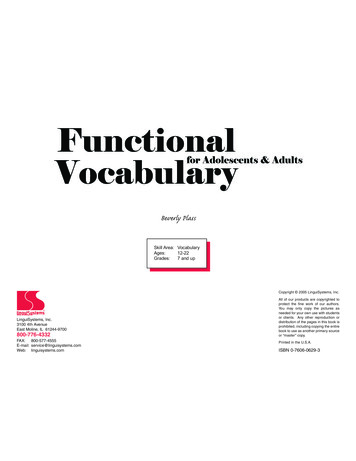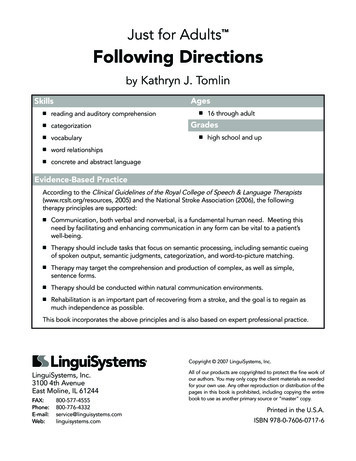
Transcription
Just for Adults Following Directionsby Kathryn J. TomlinAgesSkills reading and auditory comprehension categorization vocabulary word relationships concrete and abstract language 16 through adultGrades high school and upEvidence-Based PracticeAccording to the Clinical Guidelines of the Royal College of Speech & Language Therapists(www.rcslt.org/resources, 2005) and the National Stroke Association (2006), the followingtherapy principles are supported: Communication, both verbal and nonverbal, is a fundamental human need. Meeting thisneed by facilitating and enhancing communication in any form can be vital to a patient’swell-being. Therapy should include tasks that focus on semantic processing, including semantic cueingof spoken output, semantic judgments, categorization, and word-to-picture matching. Therapy may target the comprehension and production of complex, as well as simple,sentence forms. Therapy should be conducted within natural communication environments. Rehabilitation is an important part of recovering from a stroke, and the goal is to regain asmuch independence as possible.This book incorporates the above principles and is also based on expert professional practice.Copyright 2007 LinguiSystems, Inc.LinguiSystems, Inc.3100 4th AvenueEast Moline, IL service@linguisystems.comlinguisystems.comAll of our products are copyrighted to protect the fine work ofour authors. You may only copy the client materials as neededfor your own use. Any other reproduction or distribution of thepages in this book is prohibited, including copying the entirebook to use as another primary source or “master” copy.Printed in the U.S.A.ISBN 978-0-7606-0717-6
About the AuthorKathryn J. Tomlin, M.S., CCC-SLP, has been a speech-languageclinician in hospitals, rehabilitation centers, and in long-term care facilitiesfor over 25 years. She has authored many materials with LinguiSystemsover the last 20 years. Some of her works include:Kathy and her therapy dog, ZanmiWALC 1 (Workbook of Activities for Language and Cognition)–Aphasia RehabWALC 2–Cognitive RehabWALC 8–Word FindingWALC 9–Verbal and Visual ReasoningWALC 10–MemoryWALC 11–Language for Home ActivitiesThe Source for Apraxia TherapyZanmi, Kathy’s Samoyed, goes to work with her to encourage the clients.Her clients enjoy feeding and spending time with Zanmi, and Zanmienjoys their company. Everybody wins!DedicationThis book is respectfully dedicated to Danielle Fedele. Thanks for all your help in usingthe exercises in this series of books. I couldn’t have done it without you. May yourjourney in the world of speech/language pathology be fulfilling and fruitful.Edited by Lauri WhiskeymanPage Layout by Christine BuysseCover Design by Jeff TaylorIllustrations by Margaret Warner
Table of ContentsIntroduction . . . . . . . . . . . . . . . . . . . . . . . . . . . . . . . . . . . . . . . . . . . . . . . . . . . . . . 4Screening . . . . . . . . . . . . . . . . . . . . . . . . . . . . . . . . . . . . . . . . . . . . . . . . . . . . . . . . 6One Step—Body Movement . . . . . . . . . . . . . . . . . . . . . . . . . . . . . . . . . . . . . . . . . . 7Two Step—Body Movement . . . . . . . . . . . . . . . . . . . . . . . . . . . . . . . . . . . . . . . . . 9Three Step—Body Movement . . . . . . . . . . . . . . . . . . . . . . . . . . . . . . . . . . . . . . . .11Two Component Directions—Concrete . . . . . . . . . . . . . . . . . . . . . . . . . . . . . . . . 12Two Component Directions—Concrete & Abstract . . . . . . . . . . . . . . . . . . . . . . . 13Two Component Directions—Abstract . . . . . . . . . . . . . . . . . . . . . . . . . . . . . . . . . 14Four Component Directions—Concrete . . . . . . . . . . . . . . . . . . . . . . . . . . . . . . . . 15Four Component Directions—Concrete & Abstract . . . . . . . . . . . . . . . . . . . . . . . 16Four Component Directions—Abstract . . . . . . . . . . . . . . . . . . . . . . . . . . . . . . . . 17Varied Written Directions . . . . . . . . . . . . . . . . . . . . . . . . . . . . . . . . . . . . . . . . . . . 18Directions with Numbers . . . . . . . . . . . . . . . . . . . . . . . . . . . . . . . . . . . . . . . . . . . 20If Condition Directions . . . . . . . . . . . . . . . . . . . . . . . . . . . . . . . . . . . . . . . . . . . . . 21Complete Items from Directions . . . . . . . . . . . . . . . . . . . . . . . . . . . . . . . . . . . . . . 23One Step, Two Component Directions . . . . . . . . . . . . . . . . . . . . . . . . . . . . . . . . . 25Two Steps, Four Component Directions . . . . . . . . . . . . . . . . . . . . . . . . . . . . . . . . 26Pictures with Directions . . . . . . . . . . . . . . . . . . . . . . . . . . . . . . . . . . . . . . . . . . . . 28Making Words . . . . . . . . . . . . . . . . . . . . . . . . . . . . . . . . . . . . . . . . . . . . . . . . . . . . 30Following Written Directions . . . . . . . . . . . . . . . . . . . . . . . . . . . . . . . . . . . . . . . . 32Directions with a List of Items . . . . . . . . . . . . . . . . . . . . . . . . . . . . . . . . . . . . . . . 35Map . . . . . . . . . . . . . . . . . . . . . . . . . . . . . . . . . . . . . . . . . . . . . . . . . . . . . . . . . . . . 37Answer Key . . . . . . . . . . . . . . . . . . . . . . . . . . . . . . . . . . . . . . . . . . . . . . . . . . . . . 39Just for Adults: Following Directions3Copyright 2007 LinguiSystems, Inc.
IntroductionFollowing directions is an integral part of our daily communication and functioning. We have to followdirections in various ways for a multitude of activities every day. We follow directions when we use arecipe, carry out the responsibilities of a job, build something, pay our bills, drive to a new location, andso on. The ability to follow directions is frequently impaired in someone who has language or thinkingdifficulties. Life and communication can become very confusing and frustrating when the ability tofollow directions is impaired.Many factors can hinder one’s ability to follow directions, such as: Difficulty understanding language or concepts due to aphasia.Difficulty with mentally manipulating information and then acting upon it.Impulsivity, causing action before receiving and analyzing all pertinent information.Difficulty following a multimodality task.Perseveration, causing an inability to shift from how one task is done to a different method.Difficulty attending to and completing multi-step activities.The exercises in Just for Adults: Following Directions have been developed to address differentforms and processes involved in following directions. In some of the sets of activities, the items getprogressively harder. The later exercises use the underlying processes targeted in the initial exercises.The exercises can be done in multiple ways. Have clients read items silently and complete them independently.Have clients read task items aloud and perform the action or write the response. In general,performance improves when a person has multi-modality input (i.e., hearing it while reading it.)Read the items to the client and have the client respond appropriately.On page 6, you will find a screening tool that is not to be used as a test but rather as a way to observe aclient’s use of strategies and reasoning patterns. Some questions to think about while observing how theclient completes the screening include:1.2.3.4.5.Does the client need to use verbal rehearsal to aid comprehension?Is the client impulsive, and does his impulsivity lead to errors?Does the client read too much into the task and become confused?Is the client aware of his error responses?Does the client ask for clarification when having difficulty or does he just keepgoing, whether the item is understood or not?6. Does the client miss salient information?7. Is the client able to think convergently and divergently?8. Does the client have trouble shifting from one task to the next?Just for Adults: Following Directions4Copyright 2007 LinguiSystems, Inc.
Introduction, continuedThese guidelines will help you present the activities in this book. The exercises are not for testing purposes. Try to make them as enjoyable as possible. Talkingabout the specific task items, particularly when correcting error responses, will help to improvethe client’s ability for achieving the goals. Do not get into debates if the client is unable to seeanother viewpoint for a response. Just move on to the next item. Review common direction words and practice the appropriate motor response beforebeginning a section of activities. For example, ask the client to draw a circle, a box, orunderline. Write examples on index cards for future reference if necessary. Help the client associate directions to appropriate body parts before asking him to follow thedirection. For example, when he hears the word wink, which body part does he associatewith it? Be flexible with presentation and accept answers that differ from your viewpoint if the personcan give a logical explanation. The answers in the Answer Key are provided as a referenceand are not intended to be all inclusive.I hope you and your clients find these exercises enjoyable and beneficial.KathyJust for Adults: Following Directions5Copyright 2007 LinguiSystems, Inc.
Screening1. Rub your arm, blink your eyes, then touch your knee.2. Underline the coldest. Then, put an X on the tool.bathpliersiciclecoal3. Cross out any word that begins and ends with S.stampscissorsbarkssixes4. If a dog shaves, circle the tree. If not, go to the next direction.maplegreenweedsthorn5. Draw a clock.Put in the numbers.Set it for 9:25.6.happyShade in the square.Underline the p’s.Draw a line from the circle to the a.7.Put an O on the 2nd and on the 3rd blanks.Put an H on the last blank.Put a T before the H. Then, put a T in the first blank.Just for Adults: Following Directions6Copyright 2007 LinguiSystems, Inc.
One Step—Body MovementFollow these directions.1. Close your eyes.11. Snap your fingers.2. Give me your hand.12. Touch your head.3. Touch your ear.13. Look down.4. Pick up your foot.14. Bend your arm.5. Raise your arm.15. Touch your elbow.6. Smile.16. Blink your eyes.7. Make a fist.17. Rub your arm.8. Nod your head “yes.”18. Scratch your chin.9. Open your mouth.19. Clap your hands.10. Touch your foot.Just for Adults: Following Directions20. Cough.7Copyright 2007 LinguiSystems, Inc.
One Step—Body MovementFollow these directions.1. Cross your arms.11. Wave.2. Shake your head “no.”12. Look to the left.3. Point to the door.13. Touch your knee.4. Look up.14. Wink.5. Touch your nose.15. Point at the ceiling.6. Cross your fingers.16. Scratch your elbow.7. Straighten your arm.17. Laugh.8. Look to the right.18. Shake your arm.9. Touch your other hand.19. Frown.10. Wipe your mouth.Just for Adults: Following Directions20. Point to the floor.8Copyright 2007 LinguiSystems, Inc.
Two Step—Body MovementFollow these directions.1. Open your mouth, then touch your knee.2. Look at the door, then rub your arm.3. Close your eyes, then touch your head.4. Put your hand on your lap, then blink your eyes.5. Rub your shoulder, then scratch your arm.6. Yawn, then nod your head “yes.”7. Clap your hands, then smile.8. Raise your arm, then touch your chest.9. Look at the ceiling, then snap your fingers.10. Take my hand, then touch your ear.Just for Adults: Following Directions9Copyright 2007 LinguiSystems, Inc.
Two Step—Body MovementFollow these directions.1. Raise your arm, then smile.2. Scratch your elbow, then close your eyes.3. Put your hands together, then look up.4. Smile, then shake your foot.5. Make a fist, then scratch your chin.6. Touch your shoulder, then blink your eyes.7. Wave, then clap your hands.8. Scratch your nose, then cough.9. Turn your head, then rub your arm.10. Point to the floor, then open your mouth.Just for Adults: Following Directions10Copyright 2007 LinguiSystems, Inc.
Three Step—Body MovementFollow these directions.1. Blink your eyes, cover your mouth, then make a fist.2. Wave, look at the ceiling, then shake your foot.3. Touch your knee, nod your head, then put your hands together.4. Bend your arm, look at the floor, then laugh.5. Raise your arm, close both eyes, then clap your hands.6. Smile, scratch your elbow, then look to the right.7. Wipe your mouth, straighten your arm, then wave.8. Point to the floor, shake your arm, then wink.9. Rub your stomach, touch your chin, then blink twice.10. Pick up your foot, cross your fingers, then open your mouth.Just for Adults: Following Directions11Copyright 2007 LinguiSystems, Inc.
Two Component Directions—ConcreteFollow these directions.1. Circle the netableNovembersummer2. Underline the drink.waterrock3. Cross out the piece of furniture.rabbitbook4. Draw an X on the day of the week.blockTuesday5. Draw a box around the thing you can write tfourteenbirdpaintcage6. Draw a line over the body part.elbowsmile7. Put a check mark on the number.father8. Circle the animal.stoneJust for Adults: Following Directions12Copyright 2007 LinguiSystems, Inc.
Two Component Directions—Concrete & AbstractFollow these directions.1. Underline the toneporchdollar2. Draw a line over the food.musictree3. Circle the hardest item.doughwater4. Cross out the money.happycurtain5. Put a check mark next to the one that bounces.ballrobinshirtcharge6. Draw a box around the thing that is read.applesleepbooklatchglasscrow barsteel beamlaceceilingcereal7. Put a line over the one that breaks.quarter8. Circle the food.towerJust for Adults: Following Directions13Copyright 2007 LinguiSystems, Inc.
Two Component Directions—AbstractFollow these directions.1. Circle the largest.catanthousesofapebblejarwatersteel2. Underline the softest.pillowboard3. Cross out the one that burns.brickpaper4. Put a check in front of the one that is green.stop rsoupdustwater5. Draw a line over the one that tears.ironcloth6. Make a box around the tallest.treebush7. Put an X on the one that is crispy.juicebread8. Circle the one that is wet.saltJust for Adults: Following Directionspowder14Copyright 2007 LinguiSystems, Inc.
Four Component Directions—ConcreteFollow these directions.1. Circle the room. Then, underline the fish.songflounderkitchenphone2. Draw a line over the spice. Then, cross out the building.peppercounterglassesbank3. Underline the bird. Then, check the piece of furniture.olivesofabrochureeagle4. Draw a box around the food. Then, put a line over the tree.oakwashnoodlescurl5. Draw a line through the sport. Then, circle the transportation.baseballbuttonsneakerairplane6. Put two lines under the drink. Then, put a box around the job.neckcoffeejacketcarpenter7. Draw an X on the season. Then, circle the pet.dogteethsummerlights8. Put a check mark on the thing you sit on. Then, underline the vegetable.toothJust for Adults: Following Directionscornchair15stampCopyright 2007 LinguiSystems, Inc.
Four Component Directions—Concrete & AbstractFollow these directions.1. Cross out the dessert. Then, circle the flower.rosestreetice creamlion2. Draw a line over the red one. Then, put a box around the heaviest one.lemontomatograsstruck3. Underline the toy. Then, circle the footwear.dogshoedolleight4. Check the coldest. Then, put two lines over the sharpest.icedishtreeknife5. Draw a line through the month. Then, put an X on the state.New YorkcircleJanuaryshow6. Circle the hottest one. Then, put a check after the most expensive.smilefirediamondsoranges7. Draw a line under the weather. Then, draw a box around the hair color.nightbrunettewraprainy8. Circle the longest one. Then, draw a line over the fruit.mileJust for Adults: Following Directionscanpen16appleCopyright 2007 LinguiSystems, Inc.
Four Component Directions—AbstractFollow these directions.1. Circle the shortest one. Then, underline the one you hear.fencewebmusicinch2. Draw a box around the roughest. Then, cross out the smoothest.airglasssandpapercircle3. Put a check after the yellow one. Then, draw a line over the onethat’s inflated.lemonpotatogorillabasketball4. Circle the one that floats. Then, put a star on the cheapest one.dryercarshipstamp5. Cross out the softest. Then, draw a box around the smallest.cottonhundredshelvesant6. Put an X in front of the one that grows. Then, circle the one that can fly.helicopterpantstreeplank7. Cross out the one you tie. Then, put two lines under the loudest.sirenknotchangejuggle8. Circle the one that is shiny. Then, put a box around the oldest one.showerJust for Adults: Following Directionsantiquenew penny17mudCopyright 2007 LinguiSystems, Inc.
Varied Written DirectionsFollow the directions.1. Put a box around the word to the left of sixty.mountaincoffeesixtygiant2. Underline the words with five or fewer letters.tablecatspidershand3. Put a check beside the word that means the same as car.boatairplaneautomobiletrain4. Put a triangle over each word that begins and ends with T.pottenttaunttooth5. Cross out the one that is not worn on the feet.bootsshoesslippersgloves6. Add “ing” to the word that describes a way to cook.runfryfencechase7. Circle any word that has a similar meaning to intelligent.smartbrainywirebrilliant8. Put a line through any letter found in the word dog.dampJust for Adults: Following Directionsgoodopen18dragonCopyright 2007 LinguiSystems, Inc.
Varied Written DirectionsFollow the directions.1. Check any word that is the opposite of sad.addhappypawjoyous2. Cross out the vowels (a, e, i, o, u) in these words.manuponbustie3. Circle the ones that go slower than a car.bicyclejetturtlemule4. Write the opposite of each word above each word.yesdownbottomon5. Put a box around any word that begins with the last letter ofthe word day.flooryearyamnow6. Put a line over any word with four or more letters.somelegspongeathippodogcookjump7. Circle the animals that can be pets.sharpcat8. Add “ed” to the ones that frogs do.croakJust for Adults: Following Directionsdrive19Copyright 2007 LinguiSystems, Inc.
Directions with NumbersFollow the directions.1. Circle the number closest to 5.21416122. Underline the number to the left of 63.18639263. Put a box around the one that equals the number of days in a week.28474. Put a check next to the largest number.642796855. Draw a line from the first to the last number.933847226. Cross out the number that equals the number of years in a century.1007550107. Put two lines over the smallest number.765042338. Put an X on the number that equals a dozen.2012Just for Adults: Following Directions3207Copyright 2007 LinguiSystems, Inc.
If Condition DirectionsFollow the directions.1. If a fire burns, circle the tallest item. If not, do nothing.shackhutskyscrapercabin2. If a child is older than his mother, cross out the second word.If not, do nothing.hopmeterdrinkhike3. If a bird flies, put a box around the last word. If not, do nothing.bagsoundleftunder4. If glass breaks, cross out the cold item. If not, do nothing.snowbenchrugsun5. If a cat barks, underline the first word. If not, do nothing.bowlinchstreethot dog6. If you wear a hat on your feet, circle the shortest item. If not, do nothing.inchfootyardmile7. If a peanut has a shell, put a line over each green item. If not, do nothing.bloodleavesgrassemerald8. If you can see movies on TV, underline the one that grows.If not, do nothing.buildingJust for Adults: Following Directionsbricktree21bookCopyright 2007 LinguiSystems, Inc.
If Condition DirectionsFollow the directions.1. If a green light means stop, put an X on the things that fly.If not, do nothing.airplanecartrainkite2. If spring comes after winter, circle the flowers. If not, do nothing.tulipswaterdirtdaffodils3. If a leg is longer than an arm, underline the words beginning with T.If not, do nothing.upperteasewalnutthumb4. If a lemon is sweet, circle the things that float. If not, do nothing.boatcorkanchorstone5. If scissors cut, cross out the things hung on the wall. If not, do nothing.picturegumclearmirror6. If a worm can talk, put a line over the round items. If not, do nothing.boxballdishmicrowave7. If breakfast is eaten in the morning, put a box around the foods.If not, do nothing.houseseggsplatespancakes8. If a dog can chew on a bone, circle the one that is black.If not, do nothing.lemonJust for Adults: Following Directionscoalsnow22iceCopyright 2007 LinguiSystems, Inc.
Complete Items from DirectionsFind the appropriate picture on the right to follow the directions.1. Put two leaves on the flower stem.2. Solve the addition problem.3. Put ears on the cat.4. Write a word that begins withthe letter T on the blank.5. Shade in the sun.6. Draw three circles in the square.1, , 3, 47. Fill in the missing number.8. Draw a flame on the candle.9. Put a knob on the door.10. Draw tires on the car.3 4TJust for Adults: Following Directions23Copyright 2007 LinguiSystems, Inc.
Complete Items from DirectionsFind the appropriate picture on the right to follow the directions.1. Shade in the circle.2. Put an X on the piece of furniture.3. Write your name on the blank.4. Draw a shade on the lamp.5. Underline the item that needs a key.6. Write a 2 on the pencil.7. Put an X above the item a dog chews.8. Circle the kitchen appliance.9. Draw hands on the clock to show 2:30.10. Draw an eye on the fish.Just for Adults: Following Directions24Copyright 2007 LinguiSystems, Inc.
One Step, Two Component DirectionsASummerUse the items in the box to follow the directions.1. Underline the letter S.2. Draw an X in the circle.3. Put a box around the season.4. Draw a line from the A to the circle.5. Circle the two m’s.6. Cross out the A.Just for Adults: Following Directions25Copyright 2007 LinguiSystems, Inc.
Two Steps, Four Component Directions1 A 2 B 3 CUse the items in the boxes to follow the directions.1. Shade in the triangle. Underline the 1 and A.2. Divide the circle in half by drawing a line across the middle.Draw a line over the 2.3. Draw a line from the square to the triangle. Cross out the B.4. Put a check mark ( ) in the square. Circle the 3.5. Put a box around C. Shade in the top half of the circle.Just for Adults: Following Directions26Copyright 2007 LinguiSystems, Inc.
Two Steps, Four Component Directions1 2 A B 3 4glassf lyUse the items in the boxes to follow the directions.1. Circle the shortest word. Shade in the square.2. Draw a line from the 2 to the 3. Underline the A and B.3. Put a dot in the circle. Draw a box around the 4.4. Cross out the one that breaks. Circle the 2.5. Put a line over the 3. Underline the triangle.Just for Adults: Following Directions27Copyright 2007 LinguiSystems, Inc.
Pictures with DirectionsFollow the directions.1. Draw a line connecting the cat to the tree.2. Shade in the one worn on the head.3. Circle the one with a point.4. Write your name under the car.5. Put a box around the one with a brim.6. Draw five apples in the tree.7. Put an X on the one with wheels.Just for Adults: Following Directions28Copyright 2007 LinguiSystems, Inc.
Pictures with DirectionsFollow the directions.1. Write the number 3 above the one that is read.2. Put two small circles inside the one that is hot.3. Circle the one that cuts.4. Shade in the bottom half of the glass.5. Write the present year above the refrigerator.6. Draw a line from the book to the glass.7. Put a large X on the appliance.Just for Adults: Following Directions29Copyright 2007 LinguiSystems, Inc.
Making WordsFollow the directions to form words.1. Put an R on the second to last blank.2. Put an A on the fifth blank.3. Put an E on the second blank.4. Put a B between the E and R.5. Put a Z on the first blank.1. Put a Q on the first blank.2. Write an S on the fourth blank.3. Put a T on the last blank.4. After the first letter put a U.5. Put an E on the middle blank.Just for Adults: Following Directions30Copyright 2007 LinguiSystems, Inc.
Making WordsFollow the directions to form words.1. Put an S on the fourth blank.2. Put a U before the S.3. On the second blank, write an R.4. Put a T on the first blank and the last blank.1. Put an O on the second blank.2. Write the first letter of the alphabet on the fourth blank.3. Put an L on the first blank.4. Write T on the fifth blank.5. Write a C on the blank after the O.6. Put an E on the last blank.Just for Adults: Following Directions31Copyright 2007 LinguiSystems, Inc.
Following Written DirectionsIn the box above:1. Draw two large circles that are not touching.2. Write your name above the circle on the right.3. Put an X in the left circle.4. Write the date in the upper left corner of the box.5. Divide the right circle in half.6. Write a number between the circles.7. Put two lines under the left circle.Just for Adults: Following Directions32Copyright 2007 LinguiSystems, Inc.
Following Written DirectionsIn the box above:1. Draw a large square in the center of the box.2. Write the numbers 1–3 down the right side of the square.3. Draw a star in the middle of the square.4. Draw a small triangle under the square.5. Write your last name somewhere to the left of the square.6. Shade in the triangle.7. Draw a line from the 1 to the 3.Just for Adults: Following Directions33Copyright 2007 LinguiSystems, Inc.
Following Written DirectionsIn the box above:1. Draw a square and a circle. The circle should be to the left of the square.2. Draw a triangle inside the circle.3. Write a number between 1 and 10 under the square.4. Write the letter K between the circle and the square.5. Draw two small wavy lines inside of the square.6. Write today’s date somewhere above the circle.7. Draw an X below the figure on the left.Just for Adults: Following Directions34Copyright 2007 LinguiSystems, Inc.
Directions with a List of ncipalsoupUse the words in the box to follow these directions.1. Underline the animals.2. Put a box around each food.3. Cross out the numbers.4. Put a line over the things in a school.5. Draw a line through the words that begin with T.Just for Adults: Following Directions35Copyright 2007 LinguiSystems, Inc.
Directions with a List of Itemstablegreencatstop signpeoplestrawberryturtletomatobluebrownpolice carhorseambulancedogchairpurplebloodpeanutwigfire truckUse the words in the box to follow these directions.1. Underline each of the five things with hair or fur.2. Circle each of the three things with sirens.3. Check each of the seven things with legs.4. Put a line through each of the five things which are usually red.5. Put a box around each of the four colors.6. Put an X on each of the two things with shells.Just for Adults: Following Directions36Copyright 2007 LinguiSystems, Inc.
ELIBRARYUse these directions to travel on the above map of city blocks.1. Start at the library.2. Go one block north. Where are you?3. From there, go one block east. Where are you?4. From there, go two blocks south to the Post Office.5. From there, go 1 block west, then 1 block north.Where are you?Just for Adults: Following Directions37Copyright 2007 LinguiSystems, Inc.
MapBroad Street2nd Street3rd StreetElm StreetMaple StreetChestnut StreetYou are driving through the above map of some city blocks.1. Start at Broad and Chestnut.2. From there, go two blocks north.3. Now go west on Elm for one block.4. Now go south on 2nd Street for one block.5. Then go west on Maple for one block.Where are you?Just for Adults: Following Directions38Copyright 2007 LinguiSystems, Inc.
Answer KeyThe most likely answers are shown. Accept other logical, appropriate answers as correct.page 6page 15page 19page 23page 12page 16page 20page 24page 13page 17page 21page 25page 14page 18page 22page 26Just for Adults: Following Directions39Copyright 2007 LinguiSystems, Inc.
Answer Key, continuedpage 27page 31page 35page 28page 32page 36page 29page 33page 37page 30page 34page 3819-08-98765432Just for Adults: Following Directions40Copyright 2007 LinguiSystems, Inc.
The exercises in Just for Adults: Following Directions have been developed to address different forms and processes involved in following directions. In some of the sets of activities, the items get progressively harder. The later exercises use the underlying processes targeted in the initi
